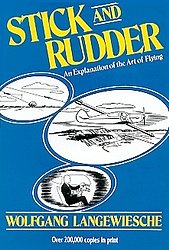|
Stick and Rudder, a Timeless Book on How to Fly
Stick and Rudder. If there ever was a book that should be on every pilots shelf, it would be Stick and Rudder. This book, written by Wolfgang Langewiesche in the early 1940s, is a book on the practicality of flying an airplane. It is not a book of theoretical information but a perspective view of flying. The book is a refreshing change from the usual flying books in that it uses common and not so common terminology. Many of the terms he uses are terms that gave way to our modern, current nomenclature in aviation. He sounds and comes across as a small aircraft pilot, not a corporate jet pilot, so the reader can relate to him in a way that only this book can. Here are some editor's comments: In the early 1940's, Wolfgang Langewiesche wrote a series of articles in Air Facts analyzing the various aspects of piloting techniques. Based on these articles, Langewiesche's classic work on the art of flying was published in 1944. This book explains precisely what pilots do when they fly, just how they do it, and why. These basics are largely unchanging. The book applies to large airplanes and small, old airplanes and new, and is of interest not only to the learner but also to the accomplished pilot and instructor. Today, several excellent manuals offer the pilot accurate and valuable technical information. But Stick and Rudder remains the leading think-book on the art of flying. WHAT'S IN STICK AND RUDDER: * The invisible secret of all heavier-than-air flight--the Angle of Attack. What it is, and why it can't be seen. How lift is made, and what the pilot has to do with it. * Why airplanes stall * How do you know you're about to stall? * The landing approach. How the pilot's eye functions in judging the approach. The visual clues by which an experienced pilot unconsciously judges: how you can quickly learn to use them. * "The Spot that does not move." This is the first statement of this phenomenon. A foolproof method of making a landing approach across pole lines and trees. * The elevator and the throttle. One controls the speed, the other controls climb and descent. Which is which? * The paradox of the glide. By pointing the nose down less steeply, you descend more steeply. By pointing the nose down more steeply, you can glide further. * What's the rudder for? The rudder does NOT turn the airplane the way a boat's rudder turns the boat. Then what does it do? * How a turn is flown. The role of ailerons, rudder, and elevator in making a turn. * The landing--how it's made. The visual clues that tell you where the ground is. * The "tail-dragger" landing gear and what's tricky about it. This is probably the only analysis of tail-draggers now available to those who want to fly one. * The tricycle landing gear and what's so good about it. A strong advocacy of the tricycle gear written at a time when almost all civil airplanes were taildraggers. * Why the airplane doesn't feel the wind. Why the airplane usually flies a little sidewise. * Plus: a chapter on Air Accidents by Leighton Collins, founder and editor of AIR FACTS. His analyses of aviation's safety problems have deeply influenced pilots and aeronautical engineers and have contributed to the benign characteristics of today's airplane. If Stick and Rudder is not already on your coffee table, get a copy today.
|





